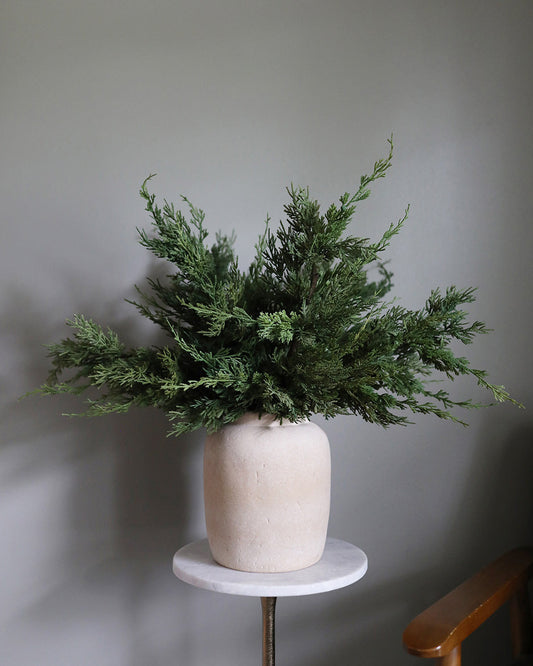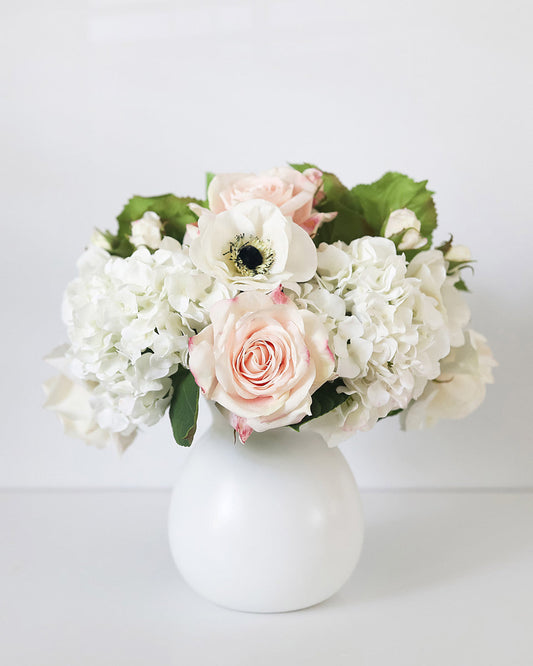Real or Faux? Secrets to Making Artificial Flowers Look Like the Real Thing

Artificial flowers have come such a long way from their plastic-looking predecessors. Modern faux flowers are crafted with incredible attention to detail, often using real-touch materials that mimic the texture and appearance of fresh blooms. While high-quality artificial flowers can stand as a stunning statement on their own just as they are, there are techniques and styling tricks to make them look as natural as possible. From understanding design principles like the rule of thirds to mastering bending and shaping stems, this article will reveal a few floral secrets to creating lifelike arrangements.
UNDERSTANDING THE RULE OF THIRDS IN FLORAL DESIGN
One of the foundational principles in both photography and floral design is the rule of thirds. This design rule helps create a sense of balance and visual interest in your composition, making your arrangements (and photos) feel naturally dynamic. When applied to flower arranging specifically, the rule of thirds means dividing your arrangement visually into three sections, both horizontally and vertically.
- Height: Arrange your tallest stems in the back or center, and shorter blooms toward the front or edges. This creates depth and prevents the arrangement from looking flat.
- Width: When grouping flowers, avoid centering everything in one tight clump. Instead, allow the blooms to spread across the width of the vase, leaving room for negative space. This mirrors how flowers naturally grow.
This rule of thirds helps achieve a relaxed, natural appearance, rather than a rigid, overstuffed look that can make artificial flowers seem obviously faux.
ARRANGING WITH ODD NUMBERS
One of the simplest and most effective secrets for creating a natural-looking artificial flower arrangement is to use odd numbers of flowers and/or foliage stems. This principle, often used in floral design, creates a more visually pleasing and organic look because odd numbers offer a sense of asymmetry, which is key to mimicking the wild beauty of nature.
- Why odd numbers work: In nature, flowers and plants rarely grow in perfect symmetry. Using odd numbers, such as 5, 7, or 9 stems, helps to replicate this natural unevenness, making the botanical arrangement look more authentic.
- Variety in height and placement: When working with odd numbers, arrange flowers at varying heights as well. For example, in a group of three stems, one might be slightly taller, with the other flowers staggered. This creates depth and movement, preventing your design from looking too uniform or stuffy.
- Balancing visual weight: Odd numbers help distribute visual weight evenly across the arrangement without making it feel overly balanced or too “perfect.” This makes the eye naturally move through the botanical display, giving it a more organic and lifelike appearance.
Whether you’re working with a few large statement flowers or several smaller stems, grouping in odd numbers is a classic design rule that adds to the realism and aesthetic appeal of your botanical creations.

BENDING AND SHAPING FAUX BOTANICALS
One of the most simple yet powerful tricks for making faux botanicals appear more realistic is the act of bending and shaping the stems, leaves, and flower petals where possible. When artificial flowers come out of the box or are pulled from storage, they often have straight, stiff stems that don’t reflect how real flowers behave. Nature is perfectly imperfect - so should your floral designs be.
- Bend the stems slightly to mimic the way flowers grow toward sunlight. For example, sunflowers and tulips naturally have curved stems, so gently shape them to follow this pattern.
- For arrangements that mimic a freshly picked and placed feel, bend and shape your botanicals stems in assorted directions, making sure to curve some stems downward for a natural, cascading feel.
- Shape the leaves by pulling them out and spreading them apart. Some faux foliage offer fully wired leaves, take advantage of this feature by curving some of the leaves out and down. Gently bent leaves create a more natural flow and appearance.
- Remember: Adjust the blooms by turning some forward, some to the side, and allowing a few to face slightly downward, as real flowers rarely stand perfectly upright.
The simple act of shaping adds life and dimension to your arrangement, giving it that relaxed, beautiful, organic feel of a fresh floral display.
COLOR MATCHING AND MIXING
To make an artificial flower arrangement look authentic, choosing the right colors is key. Color matching can help you avoid overly saturated or unnatural hues that give away the faux nature of the blooms. When selecting your artificial flowers, keep a few principles in mind:
- Opt for blended colors. Flowers that are one flat, bright color often look less realistic. Opt for blooms with soft gradients, variations in tone, or subtle highlights, which replicate how real flower colors appear an nature.
- Using the color wheel can help you create eye-catching combinations. Complementary colors—those opposite each other on the color wheel, such as red and green or purple and yellow—create vibrant contrast that makes your artificial flower arrangement stand out. For a more cohesive, softer look, opt for analogous colors, which are next to each other on the color wheel, like shades of pink, red, and orange. For more about color harmony, please read our article about Color Harmony and Floral Design here.
- Just like in real floral arrangements, the color of the leaves should complement the flower tones. Cooler-toned flowers like lilacs or blue hydrangeas pair best with dark or silvery green or blue leaves, while warmer flowers like roses and sunflowers benefit from olive or lighter for saturated green foliage.
The balance and harmony of colors play a huge role in making artificial flowers look lifelike, so take time to create thoughtful combinations that mimic nature and bring you joy.
SIMPLE ARRANGEMENTS WITH 1-2 BOTANICAL TYPES
Sometimes, less can be more when it comes to creating an authentic-looking floral arrangements Simple, minimalist designs using only one or two flower types or foliage varieties can be stunning displays and give the feeling of believability. Sticking to a few complementary pieces helps create harmony without clutter.
- A vase filled with only one type of faux flower can make a strong statement while still maintaining a natural look. Think of a simple bouquet of white hydrangeas or pale pink peonies.
- Combining one type of floral bloom with complementary greenery is another way to achieve a sleek, simple design. A few cream-colored fake roses nestled among eucalyptus leaves can look effortlessly chic and natural.
These simpler arrangements give you the opportunity to showcase the flowers themselves, allowing the colors and textures to shine without overwhelming the eye. This is an excellent technique for smaller spaces or more minimalistic interior styles.

MONOTONE BOTANICAL ARRANGEMENTS
Speaking of minimal and simple, let's talk about monotone arrangements – where all the flowers share a similar color palette – are a sophisticated approach to floral design that can look strikingly modern or timelessly classic. Here’s how to arrange keep your monotone designs interesting and natural:
- When sticking to a single color, introduce a variety of textures. Combine smooth, soft-petaled cream flowers like roses with fuzzy greenery such as dusty miller or or add intrigue with cream faux berries.
- Within a single color scheme, you can add depth by incorporating additional flowers and foliage with varying shapes. Large blooms like peonies paired with smaller, delicate peony buds or other flower stems like tulips can bring dimension to a monotone arrangement.
Achieving a balance between different shapes and textures while keeping the overall palette consistent. This creates a sophisticated, cohesive look that appears thoughtfully and beautifully designed.
PERFECT PLACEMENT FOR HOME DECOR
Where and how you place your artificial arrangements and plants in your home plays a huge role in how natural they an appear.
- Place arrangements where you would naturally find real flowers! This includes areas like dining tables with natural light, entryway consoles, kitchen counters, or bedside tables. If you place faux florals in unexpected places like near heat sources, they may feel out of place.
- To help blend artificial flowers into their surroundings, place them near other natural elements, such as wooden furniture, stone vases, or alongside living plants. This creates a look that can overall feel more organic.
- Remember to use natural light: Real flowers and plants thrive with sunlight, so placing your faux flowers in well-lit areas of your home will reinforce their lifelike appearance. Avoid dark corners or dimly lit rooms, which may diminish the vibrant, fresh effect.
Careful placement makes a huge difference in making faux arrangements feel like a natural part of your home environment and decor.

KEEP IT FRESH: CHANGE ARRANGEMENTS SEASONALLY
One final trick: change your arrangements seasonally, just as you would with fresh flowers! Fake florals offer the advantage of longevity, but rotating your botanical display to reflect the current season keeps your space feeling fresh and dynamic.
- Spring and Summer: Choose bright, lively colors or seasonally appropriate blooms such as tulips, peonies, and lilacs.
- Fall: Incorporate earthy tones of mauve, orange, and burgundy. Add in rich greens or deep reds with foliage such as oak or maple leaves.
- Winter: Focus on whites, silver tones, and deep greens. Poinsettias, magnolia leaves, and white hydrangea stems can create an elegant winter display. Add in a hint of classic holiday red with roses or amaryllis for that festive pop of color.
By switching up your arrangements, you keep your floral decor feeling updated, and guests will be less likely to notice that the flowers are artificial.
------------
When done thoughtfully, artificial flower arrangements can easily fool the eye and become a beautiful, lasting part of your home decor. With the right techniques—such as following the rule of thirds, arranging in odd number, bending and shaping stems, and selecting the right colors—you can achieve a look that rivals fresh bouquets. Whether creating minimalist arrangements or dramatic displays, incorporating faux botanicals into your home opens up endless possibilities.










